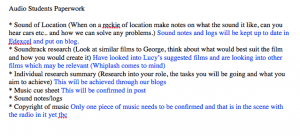Music as Added Value
At this stage of my research I decided to research ways in which music can be used to help me decide which way to go with the overall sound design of ‘George’. When looking into what music adds to a piece I found Michel Chion’s ‘Audio-Vision’(1990) very helpful. He talks generally about how sound, describing it as ‘added value’, touching on how it can transform the visual not only by adding to story, but to create links between scenes, stories and characters and the emotive factor it adds to the piece.
He then goes on to discuss music alone and describes two different effects music can have on a piece: Empathetic and Anempathetic.
“music can directly express its participation in the feeling of the scene, by taking on the scene’s rhythm, tone, and phrasing; obviously such music participates in cultural codes for things like sadness, happiness, and movement” (Chion, 1990, 8)
He describes the above as Empathetic music “the ability to feel the feelings of others”. What I can take from this idea of Empathetic music is that it makes you feel part of the audio visual experience in an affective way. It takes the emotions on screen and furthers them, this will be especially useful within my film as the story line isn’t particularly obvious. In ‘George’ the visual displays some signifiers to the overall plot and a very small amount of dialogue; therefore it’ll be important that the progression of the story is displayed clearly through sound and music. More specifically we want the audience to feel the emotions of the character George, his life story isn’t revealed to the end of the film, so it will be important to make the music emotive; with this it will guide the audience as to how to feel about George when the plot is revealed.
He then goes on to discuss what he describes as ‘Anempathetic’ music. He discusses how this is a more progressive type of music that is ‘indifferent’ to the on screen action. This creates a more intensifying effect, quite often blending with ambience sounds and foley. For me this is something that can make the music more interesting. It allows the music to feel less obvious in the sense of that it blends well with the sound design around it, allowing it not to stand out so prominently but to still be there and intensifying what is going on.
I think looking at music from both of these views has taught me where to go with the music within George. In some scenes empathetic music will be vital in helping develop the story and make the whole piece come together through linking scenes and shots smoothly. However in other scenes for example the dream sequence an anempatheitc approach will be much more relevant; this will help intensify the scene and also blend with other sounds we wish to put in like atmos and footsteps. For me a main objective for the music is for it to blend well with the overall sound design, not taking away from the ambience layers and dialogue we have put together but adding to it.
Chion, M. (1990) Audio-Vision: Sound on Screen. New York: Columbia University Press.

